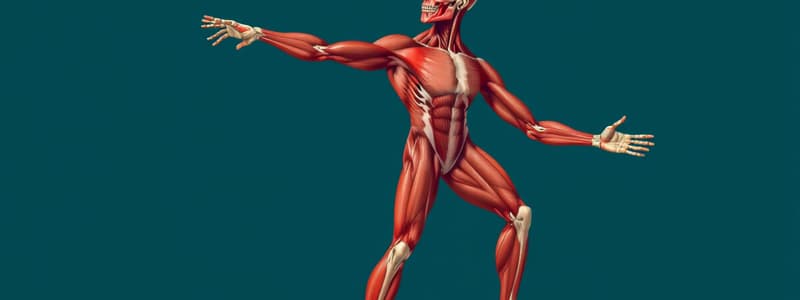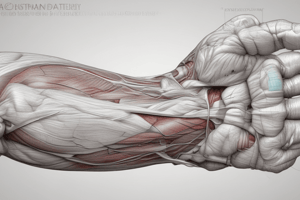Podcast
Questions and Answers
Which muscle is responsible for head rotation to the same side?
Which muscle is responsible for head rotation to the same side?
- Sternocleidomastoid
- Splenius capitis (correct)
- Trapezius
- Levator scapulae
What action does the splenius cervicis perform unilaterally?
What action does the splenius cervicis perform unilaterally?
- Head extension
- Shoulder elevation
- Neck lateral flexion (correct)
- Spinal rotation
What is the collective name for the splenius capitis and splenius cervicis muscles?
What is the collective name for the splenius capitis and splenius cervicis muscles?
- Erector spinae
- Suboccipital muscles
- Transversospinalis
- Spinotransversales (correct)
Which nerve is associated with the superficial layer muscles of the neck?
Which nerve is associated with the superficial layer muscles of the neck?
What is the bilateral action of the splenius capitis and cervicis?
What is the bilateral action of the splenius capitis and cervicis?
What is the primary function of the splenius muscles during bilateral action?
What is the primary function of the splenius muscles during bilateral action?
Which statement correctly describes the unilateral action of the splenius cervicis?
Which statement correctly describes the unilateral action of the splenius cervicis?
Which structure is involved with the innervation of the splenius muscles?
Which structure is involved with the innervation of the splenius muscles?
What characterizes the actions of the splenius capitis and cervicis collectively?
What characterizes the actions of the splenius capitis and cervicis collectively?
Which term describes the position of the splenius muscles when considering their effects on head movements?
Which term describes the position of the splenius muscles when considering their effects on head movements?
What is the primary role of the splenius muscles during unilateral action?
What is the primary role of the splenius muscles during unilateral action?
Which best describes the innervation of the splenius capitis and splenius cervicis muscles?
Which best describes the innervation of the splenius capitis and splenius cervicis muscles?
Which action is NOT performed by the bilateral contraction of the splenius muscles?
Which action is NOT performed by the bilateral contraction of the splenius muscles?
What is a common characteristic of the spinotransversales muscle group?
What is a common characteristic of the spinotransversales muscle group?
Which statement is true regarding the ipsilateral action of the splenius capitis and cervicis?
Which statement is true regarding the ipsilateral action of the splenius capitis and cervicis?
Flashcards are hidden until you start studying
Study Notes
Superficial Layer Muscles
- The superficial muscles primarily involved in neck movement belong to the spinotransversales group.
Splenius Capitis
- Positioned at the upper part of the back and neck.
- Functions to extend the head and neck when both sides contract (bilateral action).
- Facilitates lateral flexion and rotation of the head to the same side when one side contracts (unilateral action).
Splenius Cervicis
- Located beneath the splenius capitis primarily affecting the cervical region.
- Plays a role in extending the neck bilaterally and allows for lateral flexion and rotation to the same side unilaterally.
Nervous System Involvement
- Dorsal primary rami (dpr nerve) supply innervation to these muscles.
- Segmental roots connect to spinal nerves and facilitate muscle movement.
Muscle Actions
- Both splenius capitis and splenius cervicis support head and neck extension.
- They contribute to lateral flexion and head rotation, all occurring ipsilaterally (to the same side).
Summary of Functions
- The actions of the splenius muscles involve both bilateral and unilateral movements, crucial for head positioning and mobility.
Superficial Layer Muscles
- The superficial muscles primarily involved in neck movement belong to the spinotransversales group.
Splenius Capitis
- Positioned at the upper part of the back and neck.
- Functions to extend the head and neck when both sides contract (bilateral action).
- Facilitates lateral flexion and rotation of the head to the same side when one side contracts (unilateral action).
Splenius Cervicis
- Located beneath the splenius capitis primarily affecting the cervical region.
- Plays a role in extending the neck bilaterally and allows for lateral flexion and rotation to the same side unilaterally.
Nervous System Involvement
- Dorsal primary rami (dpr nerve) supply innervation to these muscles.
- Segmental roots connect to spinal nerves and facilitate muscle movement.
Muscle Actions
- Both splenius capitis and splenius cervicis support head and neck extension.
- They contribute to lateral flexion and head rotation, all occurring ipsilaterally (to the same side).
Summary of Functions
- The actions of the splenius muscles involve both bilateral and unilateral movements, crucial for head positioning and mobility.
Superficial Layer Muscles
- The superficial muscles primarily involved in neck movement belong to the spinotransversales group.
Splenius Capitis
- Positioned at the upper part of the back and neck.
- Functions to extend the head and neck when both sides contract (bilateral action).
- Facilitates lateral flexion and rotation of the head to the same side when one side contracts (unilateral action).
Splenius Cervicis
- Located beneath the splenius capitis primarily affecting the cervical region.
- Plays a role in extending the neck bilaterally and allows for lateral flexion and rotation to the same side unilaterally.
Nervous System Involvement
- Dorsal primary rami (dpr nerve) supply innervation to these muscles.
- Segmental roots connect to spinal nerves and facilitate muscle movement.
Muscle Actions
- Both splenius capitis and splenius cervicis support head and neck extension.
- They contribute to lateral flexion and head rotation, all occurring ipsilaterally (to the same side).
Summary of Functions
- The actions of the splenius muscles involve both bilateral and unilateral movements, crucial for head positioning and mobility.
Studying That Suits You
Use AI to generate personalized quizzes and flashcards to suit your learning preferences.




